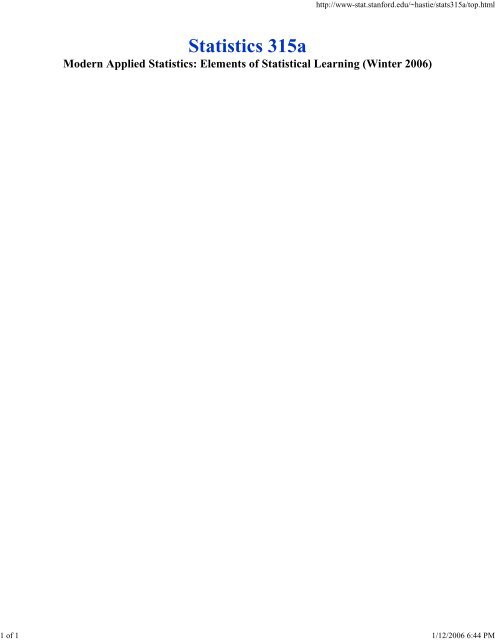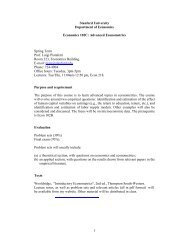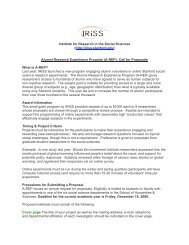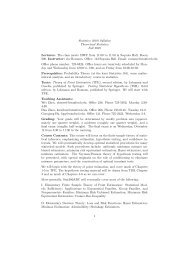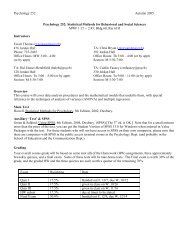Statistics 315a Home page
Statistics 315a Home page
Statistics 315a Home page
Create successful ePaper yourself
Turn your PDF publications into a flip-book with our unique Google optimized e-Paper software.
of 1<br />
http://www-stat.stanford.edu/~hastie/stats<strong>315a</strong>/top.html<br />
1/12/2006 6:44 PM<br />
<strong>Statistics</strong> <strong>315a</strong><br />
Modern Applied <strong>Statistics</strong>: Elements of Statistical Learning (Winter 2006)
Table of Contents<br />
http://www-stat.stanford.edu/~hastie/stats<strong>315a</strong>/left.html<br />
1 of 1 1/12/2006 6:44 PM<br />
Table of Contents<br />
Course Description<br />
Course Overview<br />
Contact Information<br />
Supplements<br />
Assignments
http://www-stat.stanford.edu/~hastie/stats<strong>315a</strong>/right.html<br />
1 of 3 1/12/2006 6:44 PM<br />
Course Description<br />
The meteoric rise in computing power has been accompanied by a rapid growth in the areas of statistical<br />
modeling and data analysis. New techniques have emerged for both predictive and descriptive learning that<br />
were not possible ten years ago, using ideas that bridge the gap between statistics, computer science and<br />
artificial intelligence. In this two-part series we cover many of these new methods, with emphasis on the<br />
statistical aspects of their application and their integration with more standard statistical methodology.<br />
Predictive learning refers to estimating models from data with the specific goal of predicting future outcomes,<br />
in particular regression and classification models. Regression topics include linear regression with recent<br />
advances to deal with large numbers of variables, smoothing techniques, additive models, and local<br />
regression. Classification topics include discriminant analysis, logistic regression, support vector machines,<br />
generalized additive models, naive Bayes, mixture models and nearest neighbor methods.<br />
Objectives<br />
The objectives of this course are:<br />
To learn some of the traditional as well as the more recent tools for classification and regression<br />
To understand these concepts from within a statistical decision theoretic framework<br />
To learn some of the statistical inference tools for model selection and inference.<br />
To get hands-on experience in using some of these techniques, through the homework assignments<br />
Lectures<br />
Monday, Wednesday 2:15-3:30<br />
First Lecture: Wednesday January 11, 2006<br />
Last Lecture: Wednesday March 15<br />
Location: Skilling 193<br />
This course will be broadcast online via SCPD (Stanford Center for Professional Development)<br />
Instructor<br />
Trevor Hastie, Sequoia Hall room 104, hastie@stanford.edu, 5-2231. Office hours: Wednesday after class.<br />
Secretary: Helen Tombropoulos 3-2620 Sequoia Hall first floor<br />
Teaching Assistants<br />
Mee Young Park (Head TA) (mypark@stanford.edu), Andreas Eckner (andreas@eckner.com), Yaqian Guo<br />
(yaqiang@stat.stanford.edu) and Ping Li (pingli98@stanford.edu) .<br />
Scheduled Office Hours
http://www-stat.stanford.edu/~hastie/stats<strong>315a</strong>/right.html<br />
2 of 3 1/12/2006 6:44 PM<br />
TA Day Start End Room<br />
Park ? ? ? Sequoia 237<br />
Li ? ? ? ?<br />
Guo ? ? ? Sequoia 216<br />
Eckner Thurs 2 4 Sequoia 223A<br />
E-Mail List<br />
There are four mailing lists for this class. Students who have enrolled in the class in AXESS are automatically<br />
added in the mailing list. If you are just auditing the class and would like your name to be added to the<br />
mailing list, please send an email to stats<strong>315a</strong>-win0506-staff@lists.stanford.edu. You will not be able to<br />
subscribe to the mailing list unless you get approvement from one of the staff.<br />
stats<strong>315a</strong>-win0506-staff@lists.stanford.edu: student can send professor and TAs email here<br />
stats<strong>315a</strong>-win0506-students@lists.stanford.edu: professor can reach students, but students can not post<br />
to this list<br />
stats<strong>315a</strong>-win0506-guests@lists.stanford.edu: auditors, or other guests can subscribe to this list<br />
stats<strong>315a</strong>-win0506-all@lists.stanford.edu: send email to this one address, and it will send to the other<br />
three lists. The other lists are subscribed to the "all" list<br />
Prerequisites<br />
Prerequisites: Some knowledge of probability and statistical inference, regression, linear algebra.<br />
Computing<br />
The course encourages students to have access to Splus or R. They both implement the S language, which is a<br />
programming language very useful for statistical applications.<br />
R is available for free, and runs on all platforms (including Macs). Rintro.pdf is an introduction to the R<br />
language, providing a description of basic functionality and commands. Elizabeth Purdom has an excellent<br />
introduction to R and a list of basic functions on her web<strong>page</strong> along with more specific computer labs on<br />
various subjects.<br />
Splus exists on the Leland computers, on the <strong>Statistics</strong> computing environment, and is available on many<br />
other machines on campus. If you need help getting started with Splus, have a look at S-guide.ps Splus is also<br />
available for PCs, but not for Macs.<br />
Students are encouraged to use the Emacs editor, since there exists a wonderful ESS mode for Emacs, which<br />
understands Splus and R syntax and more. Online documentation for ESS is available.<br />
<strong>Home</strong>work
http://www-stat.stanford.edu/~hastie/stats<strong>315a</strong>/right.html<br />
3 of 3 1/12/2006 6:44 PM<br />
There will be regular biweekly homework assignments. <strong>Home</strong>work will include analysis of datasets,<br />
theoretical problems, and programming assignments.<br />
<strong>Home</strong>work and other handouts will be distributed at lectures, and are available online (see the Assignments<br />
button in the left panel.) All of the homework assignments will be graded, and solutions will be made<br />
available.<br />
LATE HOMEWORK will be penalized at 5% of the maximum score per day. <strong>Home</strong>work turned in more than<br />
7 days late will not be graded. The final homework has a sharp deadline of the due date, which will be Friday<br />
March 17 at 5pm.<br />
Exam<br />
There will be no final exam for this course. The final grade will be determined entirely from the performance<br />
on assignments.<br />
Texts<br />
The course will follow closely Elements of Statistical Learning by Hastie, Tibshirani and Friedman (2001),<br />
Springer, NY. The book is available from the bookstore (class section).<br />
Other References<br />
Pattern Recognition and Neural Networks by B. Ripley, Oxfor University Press, 1995.<br />
Modern Applied <strong>Statistics</strong> with S (fourth edition) by W. Venables, and Ripley, B. Springer 2002.<br />
Machine Learning, Neural and Statistical Classification edited by Michie, Spiegelhalter and Taylor, 1994,<br />
Ellis Norwood.<br />
Pattern Classification (2nd Edition) by R. Duda, P. Hart and D. Stork, Wiley, 2000. Neural Networks for<br />
Pattern Recognition by C. Bishop, Clarendon Press, Oxford, 1995.<br />
Short Course<br />
An intensive two-day short course will be given on April 3-4, 2006 in Palo Alto:<br />
Statistical Learning and Data Mining<br />
by Professors Trevor Hastie and Robert Tibshirani. This course is also based on the text<br />
Elements of Statistical Learning , and will also cover topics in bioinformatics.<br />
Please consult the course web <strong>page</strong> regularly. The URL is http://www-stat-stanford.edu/~hastie/stats<strong>315a</strong>/


